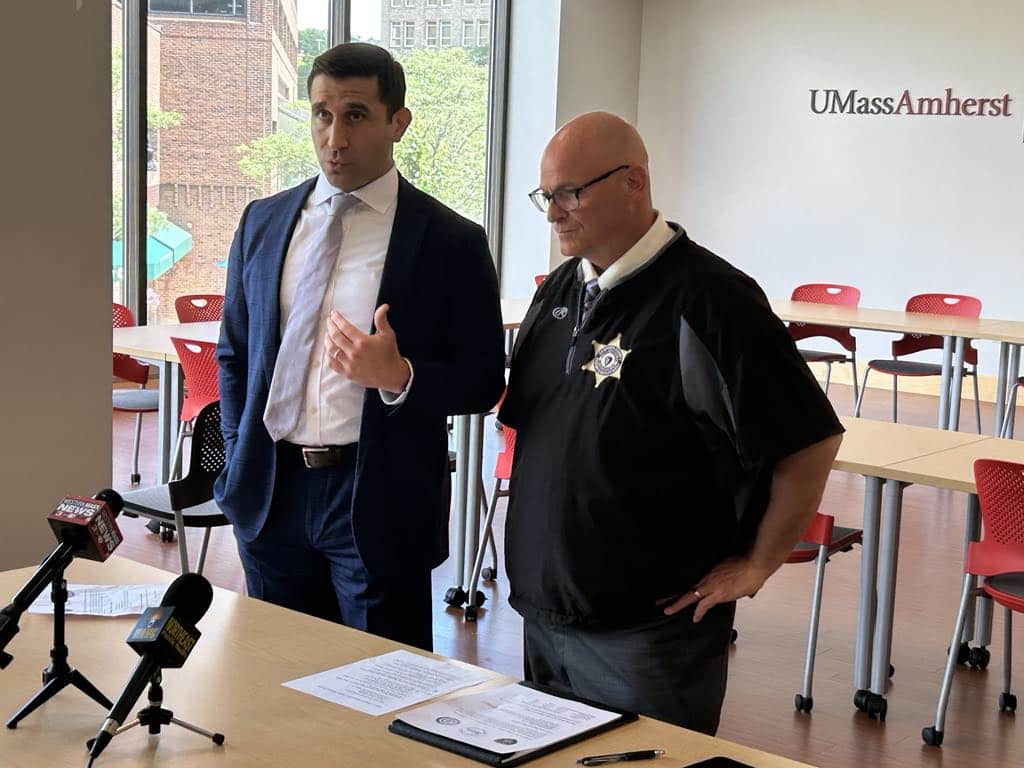Hampden District Attorney Anthony Gulluni and Hampden County Sheriff Nick Cocchi talk to the media about the work the Hampshire County Addiction Task Force is doing to curb drug addiction and overdoses during the HCAT meeting on July 9 at Tower Square’s University of Massachusetts Center.
Reminder Publishing photo by Ryan Feyre
SPRINGFIELD — Substance use disorders are still a prevalent issue in Hampden County, but according to recent data from the Critical Incident Management System, some progress has been made.
CIMS, a web-based tool that tracks overdoses across the state and beyond, reports that the county has experienced 40 fatal overdoses during the first six months of 2025, a 23% decrease over the same time frame in 2024.
According to the data, despite a recent uptick in nonfatal overdoses between May and June of this year, there have only been 245 total nonfatal overdoses between January and June of 2025 — a 16% decrease over the same six months last year.
Meanwhile, the county has seen a 50% increase in at-risk referrals in the first six months of 2025 compared to the first six months of 2024, meaning more people are trying to seek help before a problem gets worse.
Talking to the media, Hampden County District Attorney Anthony Gulluni and Hampden County Sheriff Nick Cocchi credited the Hampden County Addiction Taskforce — comprised of multiple agencies within different sectors of work — for these developments.
“We’re seeing a decrease [in overdoses and] we’re seeing an increase in active referrals, which means people are starting to hear from our people that are working so diligently on the Addiction Task Force,” Cocchi said at a July 9 meeting of the task force.
HCAT’s goal is to focus on a countywide approach to address drug addiction, overdose and prevention, using a wide array of collaborations and community resources, including local and state law enforcement, health care institutions, service providers, schools, community coalitions and families.
Led by the Hampden County Sheriff’s Department and District Attorney’s Office, the taskforce was formed 10 years ago to study and assess the necessary treatment capacity needed county-wide, formulate messages around addiction and create a forum where professionals from all over the map can share best practices around education and prevention.
In 2020, the Hampden County Sheriff’s Department formed the Rapid Response and Connection Team to provide community outreach to people in Hampden County within 24-72 hours after an overdose occurrence and to those at-risk.
Consisting of a program coordinator, sheriff’s deputies and a recovery coach, the team connects individuals to immediate services, case management follow-up and harm reduction tools such as Narcan.
Gulluni and Cocchi said this team and the task force have changed lives over the past few years.
“We’ve really done incredible work working with so many people who are out on the front lines fighting this battle,” Gulluni said. “And our primary purpose is saving lives.”
Cocchi shared that the task force has impacted around 2,200 lives over the past two years, and over 240 of those people have been placed into substance use treatment facilities.
Meanwhile, 1,600 of those 2,200 spoke with people from the task force about seeking help.
“What that does … is it changes the fabric of family cohesiveness,” Cocchi said of those numbers. “The people are trying to seek help; they’re getting the help and support from the community agencies that are out there doing such wonderful work.”
To supplement the work of the task force, CIMS launched in Hampden County in 2021 and Springfield in 2022 to track real-time overdose data by mainly using police reports. As of June 30, 16 Hampden County communities utilize the resource, according to Pam Kelley, executive director of Kelley Research Associates — which created the CIMS program.
Gulluni said that CIMS has been instrumental in keeping the task force informed about how they should approach addiction and prevention.
“We’ve seen the ebbs and flows of overdose numbers, but we’re hopeful that the work we’re doing and the data that’s provided … is really critical in how we direct and drive resources into communities where we’re seeing spikes,” Gulluni said.
According to Kelley, CIMS distinguishes itself from other programs across the country for its “multi-jurisdictional nature” as well as its effectiveness in managing and sharing overdose data.
In a world where people don’t always overdose in the communities they live in, Kelley said CIMS is able to connect where incidents occur and where people live so they can get the help they need in their hometown.
The program also features an at-risk module that can help identify who are at risk of overdosing before it is too late.
“Someone is concerned about [a] person, they might not have yet overdosed, but someone has a worry about them,” Kelley said. “So, this is a proactive role that you can play in getting resources to someone before that crisis takes place.”
Three-year data from CIMS shows that 2,640 overdose, at-risk and behavioral health incidents occurred in Hampden County between Jan. 1, 2023, and June 30, 2025. Of those, 227 were fatal overdoses, 1,585 were nonfatal, 621 were considered “at-risk individuals.”
When sharing the numbers with the task force on July 9, Kelley also pointed out the 55% of nonfatal and fatal overdoses over the past two years in Hampden County occurred in Springfield, 18% in Chicopee, 7% in Holyoke, 6% in Westfield and 5% West Springfield. She noted that 78% of overdoses in Hampden County took place in the community that the individual lives in, while 22% of overdoses took place outside of the individual’s home community.
In 2024 alone, 8% of the 734 individuals who overdosed had a second incident, while 2% had three overdoses. A total of six people who overdosed more than once died last year, the data showed.
According to Sean Varano, a senior research associate for Kelley Associates, measuring the problem through these statistics is an important piece of the puzzle, but it is not the only one.
In reality, the numbers represent a “measure of the intervention,” meaning the taskforce and Kelley Associates are using the data to further pinpoint how they can solve the problem of drug addiction and overdoses using the resources in the community.
“From a public policy point of view, it becomes critical that we know what we’re doing and quite frankly what we’re not doing,” Varano said. “What we’re trying to do is constantly make the gaps in our system as small as possible to make sure that people are not falling through those cracks.”


